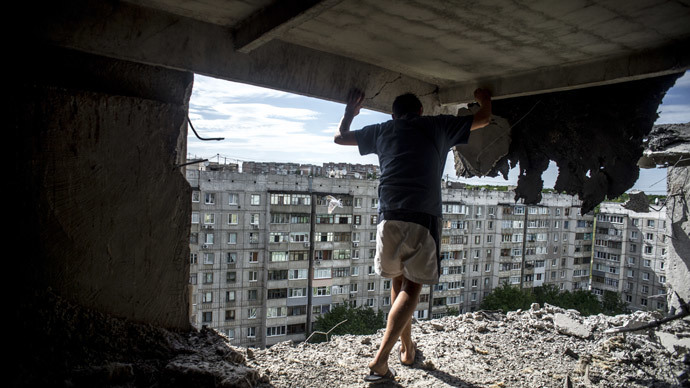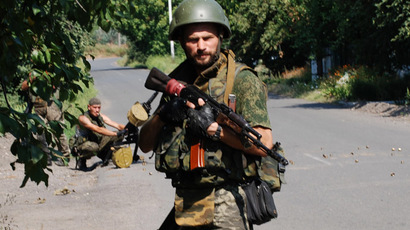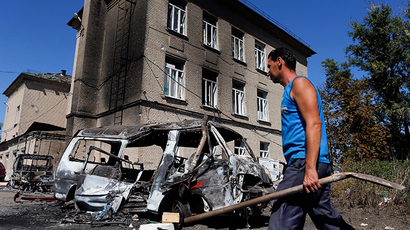HRW: Civilian death toll in E. Ukraine rising due to 'indiscriminate and unlawful' shelling

Human Rights Watch has condemned the illegality of Ukrainian actions in east Ukraine, ascribing direct blame to Kiev for the rising death toll in the Lugansk Region, which by local estimates has reached 300 since May.
The organization visited the city on August 20-22, performing a survey of the situation and carrying out interviews with locals who in one way or another were affected by the heavy bombardment, which had people cowering in fear in basements for weeks without water or electricity.
Ever since Kiev’s attempts to retake the city from the local defense forces, massive power cuts, food and water shortages, and network interruptions have taken place. The situation resembles so many other humanitarian crises, with long lines of people queuing for basic supplies – at least those not afraid to leave their basements.
“With communications cut, there is less information available about the situation in Lugansk [Luhansk] than other areas in the east,” Ole Solvang, senior emergencies researcher with the NGO said. “But the truth is, local residents are subjected to terrifying daily shelling, much of it apparently unlawful, and that the number of civilian casualties is steadily rising.”
HRW saw that many attacks failed to distinguish between civilians and combatants, which are a violation of international law and the laws of war.
Evidence of the indiscriminate nature of these attacks could be seen in the use of weaponry not meant for areas where precision is required. Projectiles with 152mm caliber aren’t intended for such missions. Nor are 350mm Smersh rockets and cluster munitions deliver by 220mm Uragan (Hurricane) rockets.
“The use of explosive weapons with such wide-area effects in
a city full of civilians is completely irresponsible and will
almost inevitably lead to civilian casualties… Whether used by
government or insurgent forces, those responsible should be held
to account for this callous disregard for civilian life,”
Solvang continued.
The local head of the medical examiner’s office, Anatoly
Tureevich, told HRW that bodies have been coming in almost daily
since May.
“The numbers vary from day to day depending on the intensity of the shelling. On July 21, we received 20 bodies, on July 22 – 5, July 23 – 3, July 26 – 18, August 4 – 17. August 14 was a bad day with 22 people. Ninety-nine percent of the civilians we receive have died from shrapnel injuries.”
These only cover civilian casualties.
While the outright lack of security on the ground made it difficult to establish whether said weapons directly led to civilian deaths, there is little doubt the majority of structural destruction was caused by them.

While Ukraine isn’t party to the Cluster Munitions Agreement of 2008, its use of large-caliber weaponry on civilian areas cannot be ignored, HRW stated, adding that it will recommend that such weapons are not used in populated areas in future.
Among HRW’s other recommendations was for the international community to put pressure on the Ukrainian government to adhere to the rules of engagement and to international humanitarian law, while also urging Russia to do what it can to appeal to the eastern self-defense forces.
The results of the survey indicate that a large majority of attacks on the city were carried out by Ukrainian government forces, while the insurgents were responsible for much fewer and targeted government positions on the outskirts of Lugansk.
An August 18 attack saw shells strike a busy central market, killing four – then striking it again in the coming days, during HRW’s visit.
Evidence, however, also points to an insurgent role in several attacks, one of which was the August 10 incident in Krasny Yar, a village just north of Lugansk, which injured two civilians when a Grad rocket struck from the direction where self-defense forces were allegedly based.
A rough statistic of injuries and fatalities has been compiled by HRW, outlining eight especially severe incidences of shelling having taken place in August – all in the most severely hit Zhovtnevy district, which underscores the very bad luck some civilians have had: medical clinics, schools, exhibition centers and other area structures had been hit, killing dozens and injuring more.
The chief of the district told the organization there were no self-defense forces in the area at the time of those attacks there.
The shelling by the Ukrainian military has only increased since August 13.

Other officials, such as firefighters, compounded the reports of difficulties faced when dealing with the consequences of such heavy assaults.
Although HRW could not get the kind of full account it would have wished, its survey team bore witness to several incidents itself: on the day it visited, one shell truck an apartment block just 200 meters from the group’s location. It counted a dozen more shells on August 21, all striking the central part of Lugansk.
The organization documented craters left after heavy bombardment downtown, some of which were dangerously close to the city hospital.
It gathered harrowing victim accounts of the ordeal undergone by the city’s residents.
In the meantime, the United States continues to place the blame on all escalation on the Russian government, purporting that it has crossed borders, or that it’s controlling the insurgency, and that it had fired upon Ukraine from its own positions near the border.
No evidence of this had been given to date. At the same time, the OSCE observers stationed in the east of the country likewise provided no evidence of Russian military involvement.














